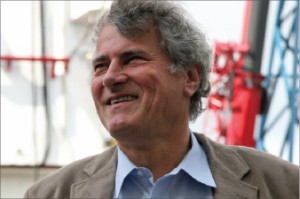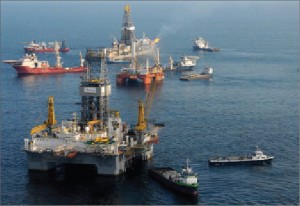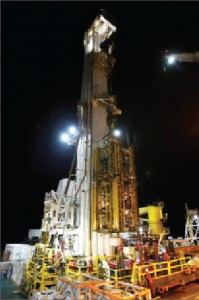Deepwater may shift from ‘bigger is better’ to more compact rigs
Critical issues in drilling & completions with Joop Roodenburg, CEO of Huisman Equipment
By Katie Mazerov, contributing editor

What are drilling contractors seeking in new rig design and performance?
Rig contractors are very concerned with safety, and this is driving innovation to remove personnel from harm’s way. Operators also are seeking reliability in rig design and construction, which leads toward lower nonproductive time. They also are looking to differentiate their performance from competitors while maintaining safe operations. This leads to application of new ways to increase value for the operator while maintaining a healthy contracting business. Of course, there is a slower uptake than operators desire because some changes require drilling contractors to retire capital investments.
Meanwhile, operators are looking for lower costs per well. This should lead to more efficient rigs. The key factors are integrated designs that can provide smaller units, offline activities and safety through automation. There is a strong trend toward implementing AC-driven equipment to replace DC, hydraulic and mechanical drives because of the significant increase in controllability of drilling operations through AC drives.
At Huisman, we have a long history of designing, installing and maintaining AC-driven equipment and complex control systems in a range of complex oilfield equipment. We always look at what the best drive is for the application, and we know how to properly integrate this into one control system.
In what areas are you seeing the most demand for innovation in rig design?
Increasing well costs are causing operators to seek a step-change in drilling innovation that will reduce costs of wells in both onshore and offshore arenas. Onshore, the growth of shale drilling has created the challenge of longer-reach wells with low-cost gas, making many wells appear to lack economic viability. These operators are specifically looking at reducing their well costs through the application of automation.

For example, Shell has made significant strides in this direction by using downhole tools that connect to the drilling rig and create an automated process. Basically, the measurement for control comes from downhole, not directly from the surface. This kind of application makes the entire drilling process more efficient. At Huisman, we believe that drilling systems automation is at a tipping point whereby it will soon grow rapidly and deliver real value.
There is also an increasing demand for drilling through low-pressure zones using techniques such as underbalanced and managed pressure drilling. Designs of rigs for these situations are looked at on a field- or region-specific basis, a trend that is increasingly being influenced by the operator. Operators are challenged because, while the technology has improved performance, it also has come at a price that has not reduced well costs. The challenge for innovation is to deliver improved performance with a commensurate reduction in well cost.
What rig innovations are needed for deepwater drilling and the trend toward subsea wells?
The deepwater market is interesting in that operators are recognizing the need for greater efficiency there. Currently, the motto for deepwater is “bigger is better,” but a strong tendency toward more compact, better integrated rigs is on its way. More compact deepwater rig designs reduce capital costs and operating costs, bringing benefits to both the drilling contractor and the operator. Our integrated rig designs allow the operator to do more offline activities such as stand building and completing the tree stack while drilling, reducing the drilling and completion time of a well. More and more companies want these features with extended operations in the deepwater. They want to complete more functions from the same rig, in parallel.
For example, in the design we did for the Noble Globetrotter drillship for Noble Drilling, the tower has two sides. One side is used for drilling operations; the other is for construction activities, such as stand building, riser construction and lowering the blowout preventer stack.

New deepwater rig designs must address the need for increased control over rig systems, as well as the demands of efficient and safe drilling. The Noble Globetrotter is a typical example of such a rig. We are currently building four compact, high-efficiency drillships for Noble Drilling and Shell. Three will be in service next year; the fourth will be operational in 2012.
A growing, innovation-oriented market is subsea well intervention. A fast-growing number of subsea wells need intervention or workover jobs. Currently, these jobs are being performed by conventional drilling rigs, which are oversized and not able to be deployed accurately enough for the work required. Smaller rigs, intended to more specifically address this kind of challenge, are being designed and are under construction. In these jobs, various types of operations, such as wireline, coiled tubing and drill pipe, have to be handled in rapid succession, demanding an unobstructed path to the well center. Building on our experience with the Q4000 and Well Enhancer construction, we now have both a semisubmersible and a monohull design that offer the kind of enhanced flexibility that increases efficiency.
The new designs feature a multipurpose tower, where multiple tasks can be performed in parallel. For example, while we are in the hole for cleaning, we can rig up the tree, run equipment to the seabed, build BHAs or perform other rig operations. The tower can perform all derrick functions. The Q4000, our first well intervention semisub, was deployed to the Macondo well site in the GOM last year to assist with the removal of the BOP.
How do you design rigs for different kinds of drilling in different parts of the world?

The end use of the rig, or basis of design, has to be looked at for specific applications and for specific areas. Externally, many factors have a role, including transport costs, regulations and high or low specifications, along with, of course, the well designs and geology. Water depth and environmental conditions also drive offshore designs, such as for jackup units, drillships or semisubmersible drilling units. Furthermore, regional requirements impact designs. A rig in Europe needs to be built to a higher specification than in the USA. Smart engineering combined with advanced manufacturing techniques and innovative designs that reduce well costs, enable high-spec rigs to be competitive in challengingly priced markets.
Huisman has developed a fast-moving modular land rig, the LOC 400 (Land and Offshore Containerized 400-ton hookload), which is an example of such a high-specification rig. This rig, which has operated in Denmark and The Netherlands, is a small-footprint rig that is easy to move and operate and has a low environmental impact, readily meeting international and European environmental regulations for noise and emissions. This is especially important because environmental influences are growing all the time, everywhere in the world. Due to the design of the rig, it does not need any special permits for road transportation. The LOC 400 predecessor, the LOC 250, is on contract to Apache Drilling in South Texas.
Specifically, what do increasingly complex wells and harsh-environment drilling mean for rig designs?

Oil companies are stepping into the specification of rigs to drive the development of technology for long-reach wells, along with operations in difficult environments. More complex wells lead to higher-capability equipment. To achieve a better repeatability of operations, there is an increasing demand on the application of automation throughout the drilling process, not just pipe handling. The application of automation must demonstrate reliability in order to be accepted.
Harsh environments, such as the offshore Arctic region, require a totally different, integrated rig design. Huisman is working on a multidraft semisubmersible, the JBF Arctic, with ice-breaking capabilities. The vessel is being model-tested on ice and also in the heavy seas environments.
What technology gaps still exist, and where do you see the industry heading in the future?
I think the industry is moving toward automation to reduce human exposure to hazardous areas and to optimize drilling efficiency by removing human inconsistencies. We are missing the people on the rigs required to operate these systems. The new technology is not necessarily more difficult, but it requires different competencies and skill sets, such as high-level computer skills, to operate and maintain them. Automation also requires longer commissioning and testing time. In general, the industry does not allow enough time for the commissioning and testing phase.
Industry events hosted by IADC and SPE have concluded that a defined integrator role over the total drilling system is required to implement automation fully into the drilling process. But integration is difficult in this fragmented industry. This is a business that, historically, has been slow to adapt to new technology, and it often takes a long time to convince people of the benefits. But I think people are starting to change.
